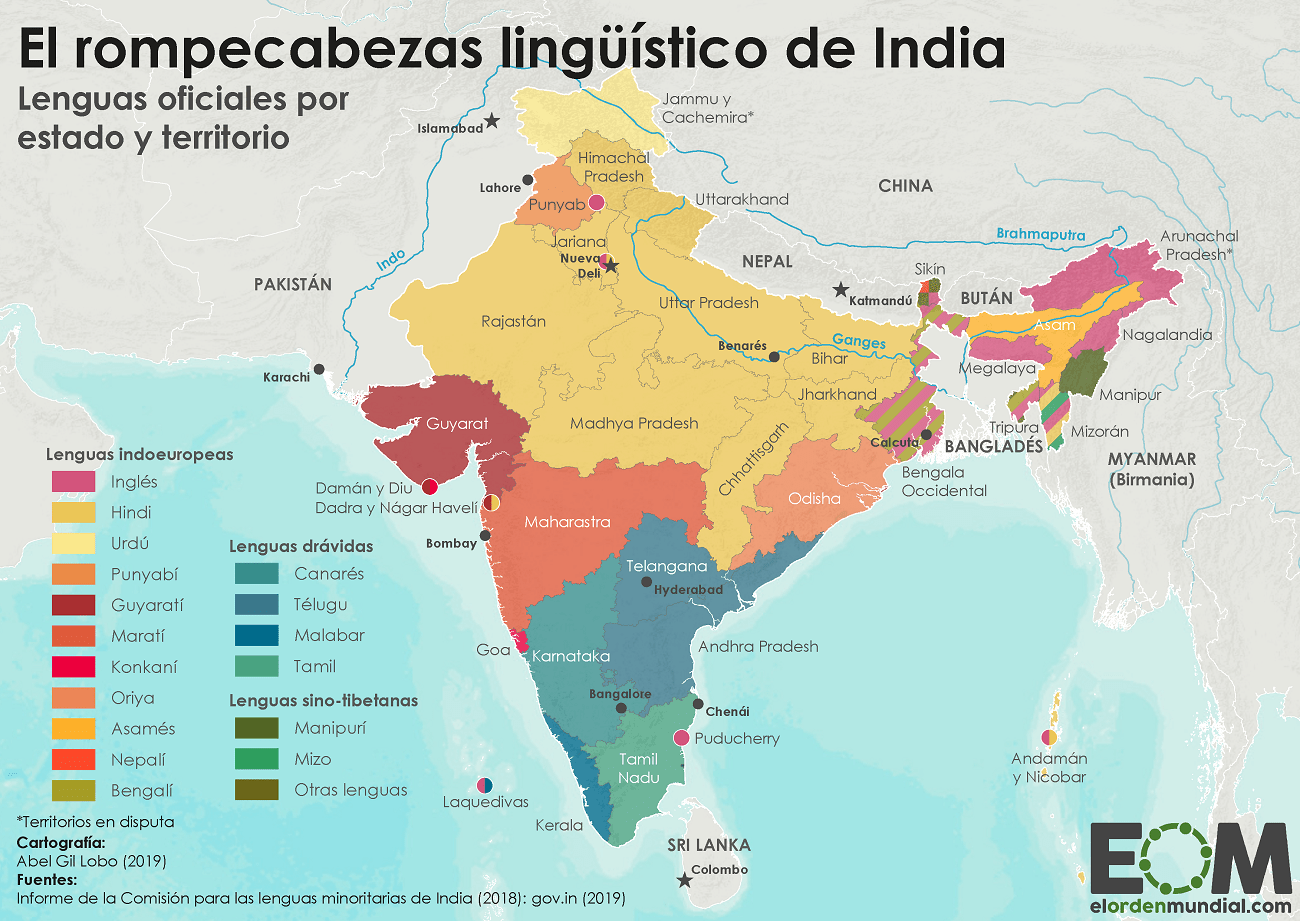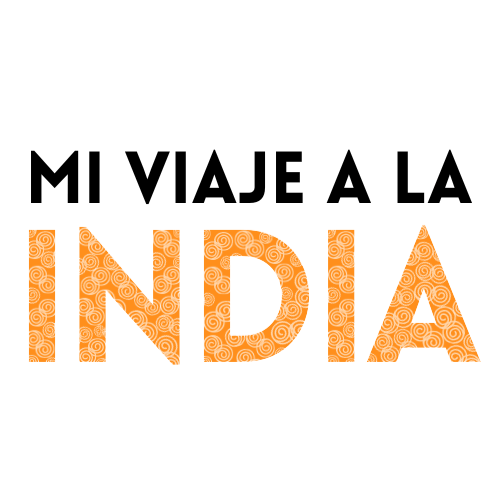Did you know that India has 22 languages recognized as official languages? The country of diversity is home to 400 languages and almost 2,000 dialects marked by the country's history. I will tell you all the details about the languages of India
What language do they speak in India? How many languages are there in India?
As you may know, India is an extremely large country in size and population. It has an enormous cultural richness that has always been nourished by all those cultures that have passed through its lands throughout history. All these cultures have left their mark in the history of the country, its gastronomy, customs and also in its languages and dialects.
India has 22 official languages (Hindi being the most widely spoken), 400 languages and almost 2000 dialects.
The majority of the population is multilingual, they can speak English, Hindi and a mother tongue. English is usually the communication tool between the Northern and Southern states, as Hindi is not widely spoken in the South.
Due to linguistic diversity, banknotes (rupees) have the monetary amount written on the back in 15 different languages.
Origin of Indian languages
The languages spoken in India are very varied and extremely different due to the fact that come from different roots or linguistic families. Mostly there are 4 roots:
- Indo-European language: predominates in the northern states with languages such as Hindi, Marathi, Bengali, Assamese, Dogri, Gujarati, Kashmiri, Konkani, Maithili, Nepali, Oriya, Punjabi. Sanskrit, Hindi, Urdu, Bengali and Punjabi belong to the Indo-Aryan subgroup. During the Muslim invasion in the 12th century, the most widely spoken languages in northern India were those derived from Persian and Iranian.
- Dravidian root or dravidian root: predominates in the south with languages such as Tamil, Malayalam, Kannada and Telugu.
- Sino-Tibetan roots: Manipuri and Bodo.
- World Languages: Santali is classified as a Munda language, and the origin of these languages is not known with certainty.
Languages of India (official)
The Constitution of India recognizes 23 official languages including 22 Indian languages and English.

If you have doubts about what language they speak in India, below I indicate each of the languages of India and the states and even other countries where this language is the official language:
Hindi: Delhi, Haryana, Himachal Pradesh, Rajasthan, Uttar Pradesh, Bihar, Chandigarh, Chhattisgarh, Jharkhand, Madhya Pradesh, Uttarakhand, Andaman and Nicobar Islands.
Tamil: Tamil Nadu and Pondicherry. It is one of the oldest languages in the world. It is also one of the official languages of Sri Lanka and Singapore.
Sanskrit: is a classical language, one of the oldest in the world and the language in which the Vedas were written. It is currently spoken by 190,000 people and is still used in some universities, ceremonies and in various media.
Bengali: West Bengal and Tripura. It is also the official language of Bangladesh
It is also the mother tongue of Rabindranath Tagore, poet and Nobel Laureate in Literature who described the Taj Mahal as "a tear on the cheek of time".
Nepali: Sikkim and Darjeeling. It is also the official language of Nepal
Asames: Assam
Bodo: is the second official language of Assam
Gujarati: Dadra, Gujarat, Nagar, Haveli, Daman and Diu
Cachemiro: Jammu and Kashmir
Urdu: Jammu and Kashmir (lesser number of speakers than Kashmir)
Dogri: Jammu and Kashmir. It is also spoken in Punjab and Himachal Pradesh.
Punjabi: Punjab
Canarese or Kannada: Karnataka. It is one of the oldest languages in the world
Malabar or Malayalam: Kerala and Lakshadweep
Konkani: is spoken in Kerala, although it is the official language of Goa.
Oriya: Orissa
Marathi: Maharashtra. It has 42 different dialects
Sindhi: is spoken in the Pakistani province of Sind and the Indian border.
Maithili: Bihar
Santali: official language in Jharkhand but also spoken in Bengal and Bihar.
Manipuri: Manipur (of Indo-Tibetan origin)
Telugu: Andhra Pradesh
The official Indian languages of each state and territory of India:
Languages of India by States:
- Official language of Andhra Pradesh: telugu
- Official language of Arunachal Pradesh: English
- Official language of Assam: asames
- Official language of West Bengal: Bengali
- Official language of Bihar: Hindi. Urdu is recognized although it is not an official language.
- Official language of Chhattisgarh: hindi
- Official language of Goa: Konkani. Marathi is recognized although it is not an official language.
- Official language of Gujarat: Gujarati
- Official language of Haryana: hindi
- Official language of Himachal Pradesh: hindi
- Official language of Jammu and Kashmir: urdu
- Official language of Jharkhand: hindi
- Official language of Karnataka: Kannada
- Official language of Kerala: English, Malabar
- Official language of Madhya Pradesh: hindi
- Official language of Maharashtra: marathi
- Official language of Manipur: manipurí
- Official language of Meghalaya: English
- Official language of Mizoram: mizo
- Official language of Nagaland: English
- Official language of Orissa: English, oriya
- Official language of Punjab: panjabi, sindhi
- Official language of Rajasthan: hindi
- Official language of Sikkim: English although Nepali is the most widely spoken language.
- Official language of Tamil Nadu: Tamil
- Official language of Tripura: Bengali, English
- Official language of Uttar Pradesh: Hindi. Urdu is recognized although it is not an official language.
- Official language of Uttaranchal: Hindi, English.
Languages of India by territory:
- Official language of Andaman and Nicobar Islands: Hindi, English
- Iofficial language of Chandigarh: Hindi, English, Panjabi
- Official language of Dadra and Nagar Haveli: Gujarati, Marathi
- Official language of Daman and Diu: Gujarati, English
- Official language of Delhi: hindi, panjabi, urdu
- Official language of the Laquedivas Islands: juggling
- Official language of Pondicherry: English, Malayalam, Telugu, Tamil
Languages most widely spoken and their number of speakers (Indian languages)
Hindi is undoubtedly the most widely spoken and spoken language throughout the country. Hindi has 550 million users or speakers. It is followed by English with 126 million users and with a remarkable growth in the world of education, business and commerce. Bengali, Telugu, Marathi and Tamil, although in smaller proportions, also enjoy a large number of users.
- Hindi: 550 million users
- English: 126 million users
- Bengali: 90 million users
- Telugu: 84 million users
- Marathi: 84 million users
- Tamil: 67 million users
- Urdu: 59 million users
- Kannada: 51 million users
Hindi (the most widely spoken Indian language and the official language of India)
Hindi comes from the Persian word "hind" meaning "land of the Indus River.". In the 18th century, when the Indus land was invaded by the Turks, they called the native language of the area "Hindi" i.e. "language of the land of the Indus River".
Hindi is the official language of India along with English. It is also the fourth most spoken language in the world after Mandarin, Spanish and English.
Hindi is a descendant of the Sanskrit language and is part of the Indo-Aryan language family. Hindi is the official language of India and also of most states in the country, is the mother tongue of 35% of the population and is spoken by over 400 million people in India. It is also learned as a mother tongue in Nepal, Pakistan, Fiji and Mauritius.

Hindi uses the Devanagari alphabet as do many of the predominant languages in the north of the country. But due to the large number of languages and dialects, several writing systems and alphabets coexist in the same territory.
It is the language of Bollywood cinema and music. This is the reason why it has spread to many corners of the world and has more and more foreigners who, although they do not fully master it, understand it.
The Hindustani Language and its Use
Hindustani language is the term used to refer to the informal language or "street or bazaar language" of Hindi and Urdu. Hindi and spoken Urdu are very similar and if you learn one of these two Indian languages you will understand both, but they use two different writing systems based on their linguistic roots in Sanskrit and Persian.
The use of English in India
After gaining independence in 1947, there was an intention to reduce the use of English in free India as it was a symbol of the British Raj era but in practice it has not been reduced and is the co-official language of the Constitution.
English is not widely used in Indian households, except in the upper castes especially in the cities. It is used in business, technology and is also the language of the government and the Supreme Court (along with Hindi).
Over the years, Indian English has undergone adaptations and has notable pronunciation differences with Standard British English,to the extend that it is referred to by the term "hinglish" and I must admit that in some cases the accent is so different that it is difficult to understand if you are not used to it.
If you are organizing your trip to India, please note that speaking English you will have no problem getting by in cities and tourist areas , but if your plan is to visit rural or tribal areas off the beaten track you may have to resort to a translation app or a native to guide you. And if you want to get into the culture at 100%, you might want to learn Hindi :)
I share with you a link to the hindi translator so that you can have it at hand during your trip.
Now that you have a clearer picture on what language do they speak in India, I invite you to continue discovering the culture of this wonderful country.
Bibliography
Map author: EOM https://elordenmundial.com/mapas/
Map download license: https://creativecommons.org/licenses/by-nc-nd/2.5/es/


Leave a Reply